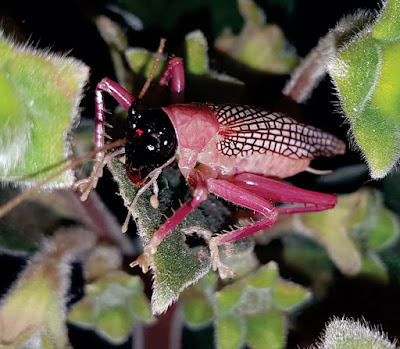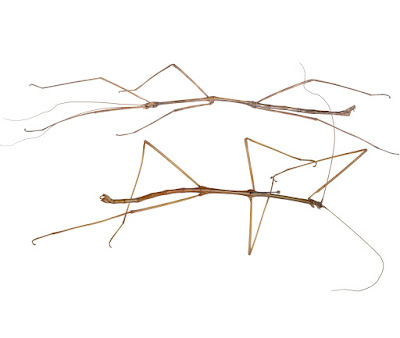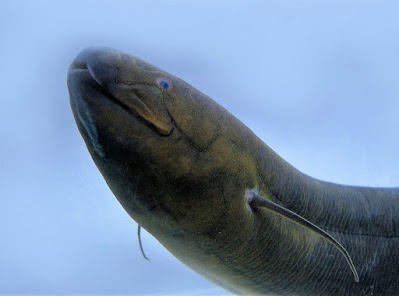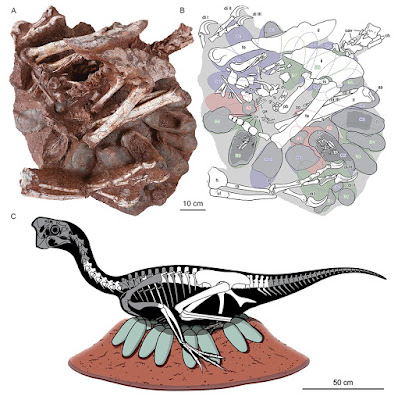[Most Recent Entries] [Calendar View]
Tuesday, December 22nd, 2020
| Time | Event | ||
| 2:15a | [Entomology • 2020] Studies on Raspy Crickets: New Triaenogryllacris Species (Orthoptera: Gryllacrididae)
Abstract The genus Triaenogryllacris is redescribed and a key for identification of the species is provided. When dealing with observations of iNaturalist, accurate data about the distribution of T. triaena (the type species) are obtained, and three color forms are indicated: yellow, pink and green. Two new species are described here: T. diaena n. sp. and T. horaciotrianai n. sp., expanding the expected geographic distribution for the genus, thus recorded, from the Andean forests of Ecuador and Colombia’s three mountain ranges. Finally, the characters and distribution of Triaenogryllacris are discussed, contrasting with the other taxa described for the family Gryllacrididae. Keywords: Orthoptera, New species, color forms, Triaenogryllacrae, Andes, distribution, iNaturalist Oscar J. Cadena-Castañeda, Carlos Julio Arango Díaz, Nixon Oscar Parra Rodríguez, Alexander García García. 2020. Studies on Raspy Crickets: New Triaenogryllacris Species (Orthoptera: Gryllacrididae). Zootaxa. 4896(2); 239–250. DOI 10.11646/zootaxa.4896.2.5 | ||
| 3:52a | [Entomology • 2020] Andeocalynda gen. nov. • A New Genus of Andean Stick Insects (Phasmatodea: “Anareolatae”: Diapheromeridae: Diapheromerinae), with the Descriptions of Nine New Species from Colombia and Ecuador [Studies on Neotropical Phasmatodea XXIV]
Abstract The new genus Andeocalynda n. gen. is described and the supposed relationships are discussed. The genus is restricted to the mountainous Andean regions of Ecuador and Colombia. Nine new species are described and illustrated: A. aspericollis n. sp., A. banosense n. sp., A. brevicercata n. sp. and A. lojaense n. sp. from Ecuador based on the males only, A. decorata n. sp., A. mutica n. sp., A. densegranuloa n. sp. and A. tuberculata n. sp. from Ecuador as well as A. putumayoense n. sp. from Colombia based on the male and female. The eggs of the two new Ecuadorian species A. decorata n. sp. and A. tenuis n. sp. are described and illustrated. Two species, previously attributed to other genera are transferred to Andeocalynda n. gen., this is: A. carrikeri (Hebard, 1919) from the genus Bacteria Berthold, 1827 (n. comb.) and A. comis (Bates, 1865) from the genus Clonistria Stål, 1875 (n. comb.). As a result, Andeocalynda n. gen. currently includes eleven known species. Keywords: Phasmatodea, Occidophasmata, Diapheromeridae, Andeocalynda, new genus, new species, descriptions, keys, revision, Colombia, Ecuador Frank H. Hennemann and Oskar V. Conle. 2020. Studies on Neotropical Phasmatodea XXIV: Andeocalynda n. gen., A New Genus of Andean Stick Insects, with the Descriptions of Nine New Species from Colombia and Ecuador (Phasmatodea: “Anareolatae”: Diapheromeridae: Diapheromerinae). Zootaxa. 4896(3); 301–341. DOI: 10.11646/zootaxa.4896.3.1 | ||
| 9:22a | [Ichthyology • 2020] Evidence of Cryptic Speciation in South American Lungfish, Lepidosiren paradoxa
Abstract For over a century, Lepidosiren paradoxa has been recognized as the single lungfish species in South America. Previous studies have failed to identify morphological differences in lungfish populations inhabiting the Amazon and Paraná–Paraguay River basins. Here, we report molecular evidence of cryptic speciation in South American lungfish. Our analysis of mitochondrial gene sequences from 56 L. paradoxa individuals collected in the Amazon and Paraná–Paraguay river systems revealed that genetic distances between individuals from different basins were on average 20 times greater than those obtained for individuals that occur in the same basin. Haplotype network did not uncover shared haplotypes between basins. Additionally, the species delimitation analysis showed that the posterior probability for the existence of distinct species is highly significant (PP = 0.99961). The phylogenetic analyses (BI and ML) recovered individuals from distinctive basins in reciprocally monophyletic clades. Our divergence time estimate suggests that the Lepidosiren in the Amazon basin are seven million years split from those that occur in the Paraná–Paraguay basin. On the other hand, in agreement with previous reports, our morphological comparison of 20 specimens from the Amazon and 14 specimens from the Paraná–Paraguay basins revealed no distinctive morphological features. The combined molecular and morphological results suggest that these two forms may represent cryptic species. Keywords: Amazon basin, cryptic species, Lepidosiren, Paraná–Paraguay basin, species delimitation Lepidosiren paradoxa Fitzinger, 1837 Jeferson Carneiro, Guilherme Moreira Dutra, Rodrigo Moreira Nobre, Luiz Marcelo de Lima Pinheiro, Pedro Andrés Chira Oliva, Iracilda Sampaio, Horacio Schneider and Igor Schneider. 2020. Evidence of Cryptic Speciation in South American Lungfish. Journal of Zoological Systematics and Evolutionary Research. DOI: 10.1111/jzs.12443 | ||
| 9:40a | [Paleontology • 2020] An Oviraptorid Preserved Atop An Embryo-bearing Egg Clutch sheds light on the Reproductive Biology of Non-avialan Theropod Dinosaurs
Abstract Recent studies demonstrate that many avialan features evolved incrementally prior to the origin of the group, but the presence of some of these features, such as bird-like brooding behaviours, remains contentious, in non-avialan dinosaurs. Here we report the first non-avialan dinosaur fossil known to preserve an adult skeleton atop an egg clutch that contains embryonic remains. The preserved positional relationship of the adult to the clutch, coupled with the advanced growth stages of the embryos and their high estimated incubation temperatures, provides strong support for the brooding hypothesis. Furthermore, embryos in the clutch are at different developmental stages, suggesting the presence of asynchronous hatching—a derived feature even among crown-group birds—in non-avialan theropods. These findings demonstrate that the evolution of reproductive biology along bird-line archosaurs was a complex rather than a linear and incremental process, and suggest that some aspects of non-avialan theropod reproduction were unique to these dinosaurs. Keywords: Oviraptorosauria, Cretaceous, Clutch, Brooding, Embryos, Asynchronous hatching Shundong Bi, Romain Amiot, Claire Peyre de Fabrègues, Michael Pittman, Matthew C. Lamanna, Yilun Yu, Congyu Yu, Tzuruei Yang, Shukang Zhang, Qi Zhao and Xing Xu. 2020. An Oviraptorid Preserved Atop An Embryo-bearing Egg Clutch sheds light on the Reproductive Biology of Non-avialan Theropod Dinosaurs. Science Bulletin. In Press. DOI: 10.1016/j.scib.2020.12.018 |
| << Previous Day |
2020/12/22 [Calendar] |
Next Day >> |






